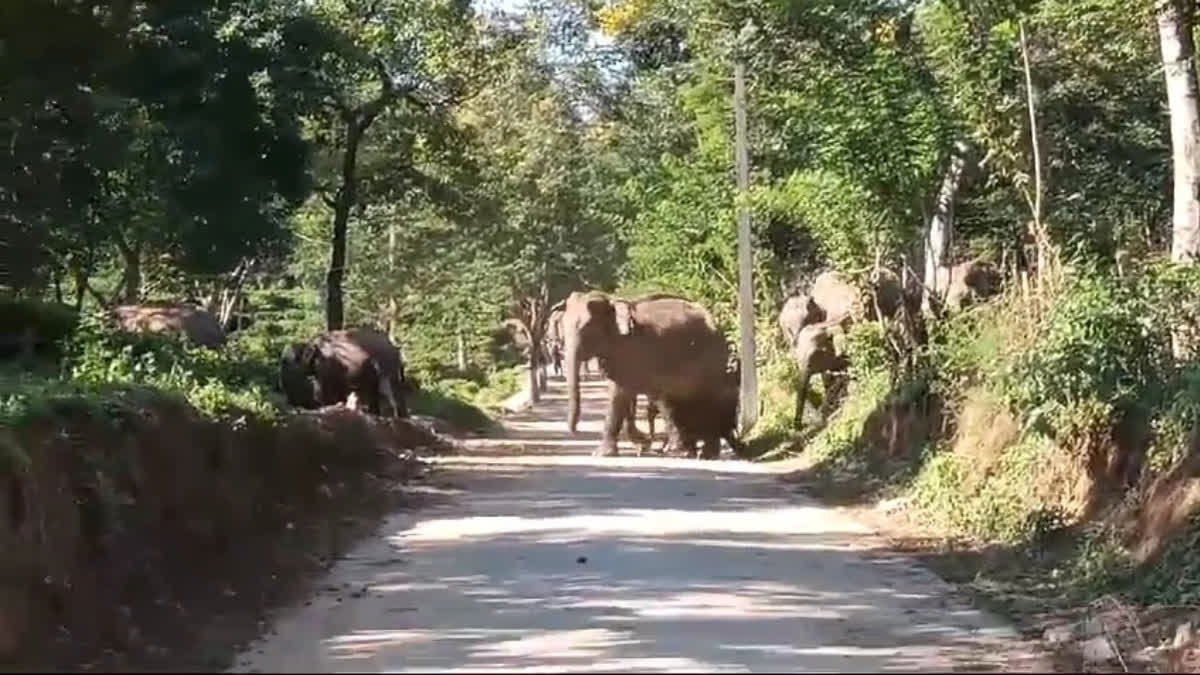Guwahati: When the elephants tread innocuously in the fragmented forests of Assam, a grace belying their massive frames, the sight is worth beholding. But with shrinking habitats, as their numbers rise, these gentle giants start trespassing the shadows of the forests and wander into areas with settlements, posing threat to humans and their assets. Not to forget, the simultaneous challenge of climate change, that can spell trouble for these creatures.
The 2024 Elephant Population Estimation (EPE) revealed a rise to 5,828 elephants, up from 5,719 in 2017, an increase of 139, a reason enough to cheer the conservation initiatives. However, how far can Assam’s delicate ecosystem sustain its growing pachyderm population, remains a lingering question.
Assam Chief Minister Himanta Biswa Sarma celebrated the milestone, calling the state a “safe haven for our gentle giants.” He took to X, and wrote "A safe haven for our Gentle Giants" while releasing the Elephant Population Estimation (EPE) 2024 on January 2 this year.
The numbers are encouraging, with stable elephant populations over decades and a robust reproduction rate, reflected in an adult female-to-calf ratio of 0.49. Additionally, anti-poaching measures have improved the tusker-to-makhna ratio to 1:1.97, a leap from 1:2.63 in 2017.
What conservationists have to say
Despite these successes, conservationists warn of a brewing crisis. “While the population growth is a matter of joy, sustainability is a pressing concern,” says Dr. Bibhuti Prasad Lahkar, an acclaimed conservationist. Habitat degradation, invasive species, and unregulated grazing are threatening the very ecosystems elephants depend on. The absence of legally notified elephant corridors further becomes a cause of concern, blocking the free movement of these animals.
Rising Numbers Of Gentle Giants Amid Shrinking Forests In Assam (ETV Bharat) Lahkar, who has recently been awarded with prestigious Neville Shulman Award, said, "there has been large-scale habitat degradation across the state, which is often forcing the pachyderms to come out to human habitations in search of food and leading to man-animal conflict." He cites increasing grazing pressure on the wild animals as many protected areas are permitted for livestock grazing and non timber forest product collection by the locals under the Forest Rights Act 2006. " The elephant corridors are yet to be demarcated properly," he stressed.
"Besides, unplanned development works have also been affecting the elephants. Their (elephants') habitats are fragmented due to the population growth," Lahkar said.
The increasing elephant population has led to a surge in human-elephant conflicts. In 2022, 64 elephants and 80 humans lost their lives in such incidents, with the numbers rising to 50 and 89 respectively in 2023. These conflicts are often fueled by elephants venturing into human habitations due to habitat loss. “Unplanned development, population growth, and shrinking forests are driving these conflicts,” Lahkar explains.
Rising Numbers Of Gentle Giants Amid Shrinking Forests In Assam (ETV Bharat) Another reason, he said, that fuels peoples' intolerance towards elephant attacks is the lack of compensation for life and damages caused by the pachyderms.
It may be mentioned here that the compensation offered by the Assam government in case of every human death in conflict with elephants is Rs. 4.5 lakh. "The compensation for damage for paddy fields and houses due to elephant raids are still minimal in Assam in comparison to other states. There is also severe red tapism which often delays the payment of ex-gratia by the government and these have forced the people to lose faith. In some places, affected people do not even apply for compensation considering that they won't get the compensation," he said.
Hailing the conservation efforts that led to rise in elephant population, conservationist and Chief of Wildlife Trust of India's (WTI) Strategy and Liaison (Northeast) Dr. Rathin Barman said there is an urgent need to address the issue of habitat destruction of the elephants. "But there are growing incidents of conflicts between elephants and humans. Their habitats are fragmented largely and we must address the issues urgently," he said.
Rising Numbers Of Gentle Giants Amid Shrinking Forests In Assam (ETV Bharat) IT may be mentioned here that that the India State of Forest Report (ISFR) 2023 which was released recently, clearly stated that the forest cover in the northeastern states continued to see a decline, with a decrease of 327.30 square kilometers in total. The ISFR 2023, which was released in December 2024, pointed out that Mizoram is the only state in the region to see an increase in forest cover while the highest decline in forest cover was seen in Assam, Meghalaya, Nagaland and Tripura.
"While states like Karnataka, Kerala and Tamil Nadu have already formed a joint coordination mechanism to ensure free movement of the elephants as an effective strategy to conserve the pachyderms, there is no such coordination in the northeastern region.
As per the estimation report, Assam’s elephant population has remained stable over decades, never dropping below 5,200. It also brought to the fore that the Adult Female to Calf Ratio was recorded at 0.49 (49 calves per 100 adult females), indicating robust reproduction and successful recruitment in the population.
Read More
